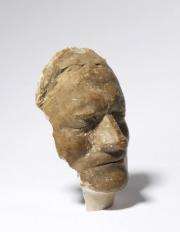Ancient and modern: First science academy is 350 years old

From its classical pillars and porticoed entrance to its oil paintings of great men and women and archives that include the death mask of Sir Isaac Newton, history sits grandly on the Royal Society.
Scientists who visit its headquarters overlooking the tree-lined avenue that runs from Trafalgar Square to Buckingham Palace tend to enter the building with the hushed awe of a religious devotee entering a shrine.
Created three and a half centuries ago this year, the academy can lay serious claim to having set down the foundations of modern science.
It promoted the demonstration of facts through experimentation. It replaced obscure Latin rhetoric with plain English as the language of scientific discourse.
It invented scientific publishing and the principle of peer review -- that a paper be assessed by independent experts -- which remains today the benchmark by which claims are vetted for credibility.
Even the Society's coat of arms, embedded in a stained-glass window, talks up the need for objectivity. "Nullius in verba" is its motto: "Take nobody's word for it."
Past fellows of the Royal Society have included Newton, Charles Darwin, Albert Einstein, Michael Faraday, Robert Boyle, James Watt and Alexander Fleming.
Contemporaries include Richard Dawkins, the evolutionary biologist, cosmologist Stephen Hawking, Tim Berners-Lee, architect of the World Wide Web and more than 130 foreigners, including more than four dozen Nobel laureates.
These minds have "changed the world by changing our understanding of it," says writer Bill Bryson, editor of a freshly-published history of the Royal Society.
Bryson says that the Society's finest achievement is to foment ideas, bringing together the best minds, regardless of class, wealth and nationality, in the quest for betterment.
"To be part of such an establishment is an extraordinary achievement. This isn't just the most venerable learned society in the world, it is the finest club."
Britain's academy of sciences traces its origins to a damp London evening on November 28, 1660 that saw a gathering of a dozen men inspired by Francis Bacon, a Renaissance philosopher who called for a planned, methodical investigation of the natural world.
They founded "a Colledge for the Promoting of Physico-Mathematicall Experimentall Learning," an idea that hardly seems revolutionary in the knowledge-based culture of today.
Those times, though, were dank, dark and superstitious.
Less than 20 years earlier, a law had been passed in England allowing for the execution of witches.
Physicians commonly sliced open veins to let out blood to balance the four "humours", or fluids believed to determine personality and disease.
The Roman Catholic Church banned the works of Galileo, deemed a heretic for concluding the planets orbited the Sun.
Through a member with access to King Charles II, the society received the royal charter and in 1665 launched its first journal, Philosophical Transactions, which flourishes to this day, the oldest continuously-published scientific journal in the world.
In 1683, a dinner conversation between three Fellows -- Edmond Halley (after whom the famous comet is named), Christopher Wren (architect who rebuilt London after the 1666 Great Fire) and Robert Hooke (first person to describe a cell) -- would be a landmark in human history.
Wren offered a prize of 40 shillings to either of his dinner partners who could explain why planets tend to orbit in an ellipse. Obsessed with finding the answer, Halley called on a brilliant but eccentric Cambridge mathematician -- Isaac Newton -- for help.
The result was the "Philosophiae Naturalis Principia Mathematica", in which Newton spelled out the universal laws of motion. Celestial mechanics, and indeed terrestrial movement, would never be the same again.
These and other extraordinary episodes of scientific history form the kernel of the celebrations in anniversary year, but the Society is also keen to stress its modernity.
It has a large stable of journals, covering a vast array of subjects, funds 1,600 scholarships each year and is big on conferences. In January, it hosted a meeting of 103 academies from around the world, including the brand-new Mozambican academy of science.
It is also keen on strengthening its contacts in Asia, which current president Martin Rees predicts will rise to the heights of scientific excellence.
Chinese scientists have become prolific publishers, accounting for 11.5 percent of the 271,000 papers that graced science journals in 2008, according to monitoring organisations.
Rees said he found little to substantiate the theory that China's Confucian tradition, in which teachers are placed on pedestals and not challenged, was a barrier to innovation.
"From the younger Chinese I've met, I don't think they're handicapped by that," Rees, a top astronomer and master of Cambridge University's Trinity College, told AFP in an interview.
"There has been a real culture change in China and it's very impressive what they're doing."
He added: "The world's intellectual firepower is going to be increasingly dominated by Asia, with its level of population and education. I am sure they are going to be the leaders in the next 50 years."
To those in Europe and North America who fear for the loss of three centuries of dominance, Rees said science was universal and all should share in its benefits.
"Science is no longer just a province of Europe and North America. It's not a zero sum game," he said. "We should welcome these developments very much."
(c) 2010 AFP

















